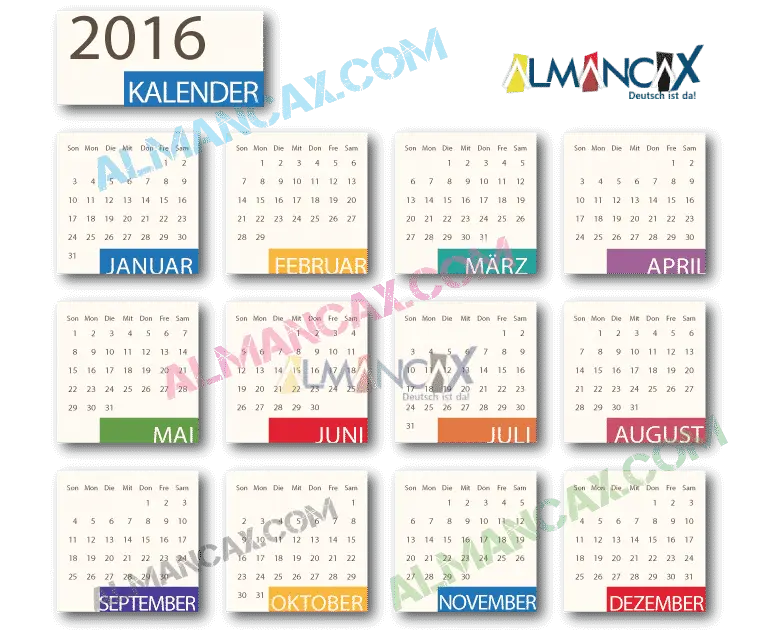German Aylar and German Seasons

Dear friends, we will see German days, German months and seasons in our lesson called German Months and German Seasons. After learning the spelling and pronunciation of the German months, the seasons and the German days, we will show you a calendar and German months and German days We will examine how it is written on the calendar.
By giving plenty of visuals in our subject, we will ensure that the subject is well understood and memorable. Since the subject of days, months and seasons in German is a widely used subject in daily life, German months It is a subject that must be thoroughly studied.
As you know, there are 12 months in a year. Your months in English as pronounced Your months in German The pronunciation and spelling are very similar. In fact, the reading and spelling of some months in our Turkish is similar to the pronunciation and spelling of the German months. German monthstopics such as days, seasons and what we will see in the future German weather Since topics such as these are among the topics that are mentioned from time to time in daily life. German months You have to memorize it thoroughly. In the meantime, it will be useful not to confuse the English months with the German months, and also to memorize their spelling and spelling differences.
We strongly recommend that you take the mini subject test under the topic after you have thoroughly identified the German months and seasons.
You may be interested in: Would you like to learn the easiest and fastest ways to make money that no one has ever thought of? Original methods to make money! Moreover, there is no need for capital! For details CLICK HERE
Now let's go to position.
German Aylar and German Seasons
First of all, see the German moon names in a table in bulk.
Then, let's list the spellings and readings of individual German months.
Then see German seasons and German days.
German Months (Die Monate)
Table of Contents
German months are shown together as a table below.
| GERMAN MONTHS and TURKISH | |
|---|---|
| January | January |
| February | Şubat |
| March | Mart |
| April | Nisan |
| May | Mayıs |
| June | Haziran |
| July | Temmuz |
| August | August |
| September | Sept |
| October | October |
| November | Kasım |
| December | Aralık |
Now you can see both the spelling and the reading of the German one by one in a list:
The parentheses indicate the readings, the: sign indicates that the preceding string will be read a little longer.
German Months Pronunciations
- January: January (Yanuar)
- February : February (february)
- March: March (meghts)
- Engagement : April (April)
- May: May (May)
- June : June (yuni)
- July : July (yuli)
- August: August (august)
- September: September (zeptemba :)
- October : October (okto: ba :)
- November : November (novemba :)
- December : December (detsemba :)
You may be interested in: Is it possible to make money online? To read shocking facts about earning money apps by watching ads CLICK HERE
Are you wondering how much money you can earn per month just by playing games with a mobile phone and internet connection? To learn money making games CLICK HERE
Would you like to learn interesting and real ways to make money at home? How do you make money working from home? To learn CLICK HERE
Example Sentences of Months in German
Dear friends, in German lessons and German textbooks, months are given with ordinal numbers in order to teach both ordinal numbers and months. For example, the name of the first month is January, the second month is February, the third month is March, the fourth month is April, etc.
We shall also see the order in German in this order, along with the number of orders:
- Der erste Monat heißt Januar
- Der zweite Monat heißt Februar
- Der dritte Monat heißt März
- Der vierte Monat heißt April
- Der fünfte Monat heißt Mai
- Der sechste Monat heißt Juni
- Der siebte Monat heißt Juli
- Der achte Monat heißt August
- Der neunte Monat heißt September
- Der zehnte Monat heißt Oktober
- Der elfte Monat heißt November
- Der zwölfte Monat heißt Dezember
German Months and Turkish Pronunciations
Let's see the German months and their pronunciation together with their Turkish in a table once. The following table includes the German months and their Turkish and pronunciation.
| MONTHS IN GERMAN AND THEIR PRONUNCIATIONS | ||
|---|---|---|
| GERMAN | IN TURKISH | READING |
| January | January | Yanuag |
| February | Şubat | februag |
| March | Mart | Meghts |
| April | Nisan | Apgil |
| May | Mayıs | May |
| June | Haziran | Yuni |
| July | Temmuz | July |
| August | August | Agust |
| September | Sept | zeptemba |
| October | October | Octo:ba |
| November | Kasım | novemba |
| December | Aralık | Detsemba |
Abbreviation of Months in German
German months are often written short on calendars, digital watches, and devices such as computers and smartphones. Now let's learn the abbreviations of the months in German.
- Januar (Jan)
- Feb (Feb)
- März (Mär/Mrz)
- April (Apr)
- Mai (Mai)
- Juni (June)
- Juli (Jul)
- August (Aug)
- September
- Oktober (Oct)
- November( Nov.)
- Dezember (Dez)
The abbreviated spellings of the German months are given above, and the abbreviated spellings usually consist of the first three letters of the month name.
German Seasons
As you know, there are 4 seasons in a year.. The fact that there are four seasons in a year is a globally accepted fact, although in some countries there are not exactly four seasons during the year. For example, in some countries of the world, a winter season may not be seen exactly as we live in our country. In some countries, the summer season is not fully experienced. But what we need to know is that there are 4 seasons in a year.
Now if you are asking German seasons Let's move on to the topic.
Aşağıda Season in german We wrote their names and their Turkish across them. You need to study it carefully and memorize it.
German Seasons:
- Herbst : Autumn Season
- Winter : Winter Season
- Frühling : Spring Season
- Sommer : Summer Season
Which months are in German which season?
| German Winter Months WINTER |
|
|---|---|
| December | Aralık |
| January | January |
| February | Şubat |
| German Springtime Months FRUHLING |
|
|---|---|
| March | Mart |
| April | Nisan |
| May | Mayıs |
| German Summer Months SUMMER |
|
|---|---|
| June | Haziran |
| July | Temmuz |
| August | August |
| Months in the German Autumn Season HERBST |
|
|---|---|
| September | Sept |
| October | October |
| November | Kasım |
In the tables above, both German seasons in these seasons German months It is shown.

| German Seasons | |
|---|---|
| spring | Spring |
| Summer | Summer |
| Autumn | Autumn |
| Winter | Winter |
We have shown the German months according to the seasons in the table above.
According to this;
Dezember, Januar and Februar months are found in winter.
In the spring season, which comes after winter, there are months of März, April and Mai.
The months Juni, Juli and August are found in the summer after spring.
In the autumn season, which comes after the summer season, there are September, Oktober and November months.
Sentence asking the question "What month are we in" in German?
Now that we have learned the topic of the German months, we can make sentences about the German months.
Do not ask the question of which month are we in German:
Welcher Monat ist heute?
(What month are we in?)
- Welcher Monat ist heute? (What month are we in?)
- Monat ist Oktober. (We are in October)
- Welcher Monat ist heute? (What month are we in?)
- Monat ist Juni. (We are in June)
- Welcher Monat ist heute? (What month are we in?)
- Monat ist April. (We are in April)
- Welcher Monat ist heute? (What month are we in?)
- Monat ist Mai. (We are in May)
- Welcher Monat ist heute? (What month are we in?)
- Monat ist Januar. (We are in January)
Dear friends, after learning the German months, let's now briefly give information about the German days, since they are related to the subject. We have already explained the subject of German days under a separate title with various examples. Here, we will give a brief summary as it is related to the subject.
German Days
| German Days | |
|---|---|
| Monday | Pazartesi |
| Tuesday | Tuesday |
| Wednesday | Wednesday |
| Thursday | Thursday |
| Friday | Cuma |
| Saturday | Saturday |
| Sunday | Sunday |
German Days Pronunciations
The following table includes the pronunciation of the German days and their Turkish meanings.
| German Days Pronunciations | ||
|---|---|---|
| German | in Turkish | pronunciation |
| Monday | Pazartesi | Monday |
| Tuesday | Tuesday | Di:nztag |
| Wednesday | Wednesday | Mitvoh |
| Thursday | Thursday | Denmark |
| Friday | Cuma | fghaytag |
| Saturday | Saturday | Zamstag |
| Sunday | Sunday | Zontag |
Days and Months in German Calendar
Below is a sample calendar prepared by our site. German months and days are generally shown on calendars as follows.

German months and seasons you are reading our story German Days you can read our subject on a separate page.
German Months and Seasons Subject Test
German tests are in our topic German months We recommend you to solve the test, dear friends. German months and German seasons are a subject that is usually taught in 9th grade. Students who have not taken enough German lessons in 9th grade can also see German months in 10th grade. On the other hand, students who start foreign language learning at an earlier age can take the German months and German seasons course in the 6th-7th or 8th grade.
We look forward to your questions about the German months.
You can write any questions and comments about our German lessons on almancax forums.
Join the almancax forums with more than 35.000 registered members, and enjoy learning German online together.
Almancax has everything you need to learn German.
The almancax team wishes success ...
Let's Test Ourselves: German Months
What are the months in German?
German Months:
January: Januar
February : February
March: März
April: April
May: Mai
June: Juni
July: Juli
August: August
September: September
October: Oktober
November: November
December: Dezember
How to pronounce months in German?
The Turkish and pronunciation of the German months are as follows:
January: Januar (yanuar)
Feb: Februar (februar)
March: März (megts)
April: April (april)
May: Mai (may)
Jun: Juni (yuni)
July: Juli (yuli)
August: August (august)
September: September (zeptemba :)
October: Oktober (okto: ba :)
November: November (novemba :)
December: Dezember (detsemba :)
What month is Januar?
Januar in German is January.
What month is Juni?
In German, Juni is the month of June.
What month is September?
In German, September is September.
